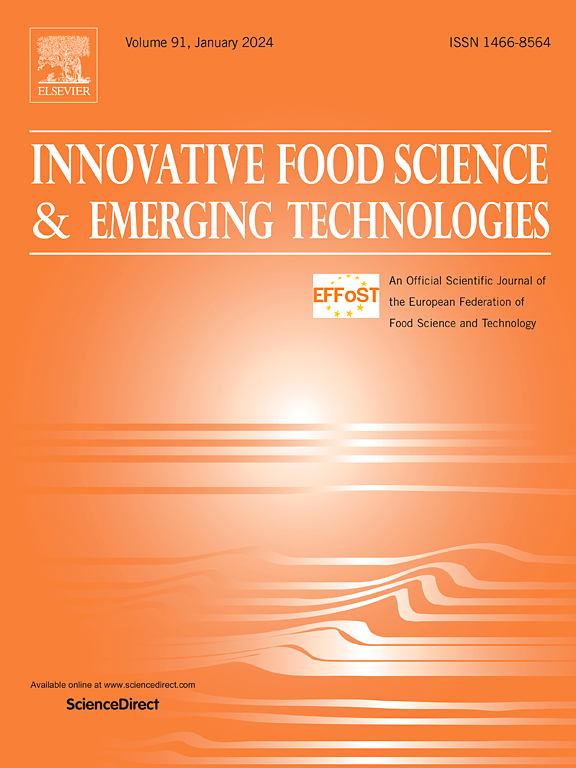Exploring the use of rice bran and mung bean as soy substitutes in low-moisture extruded plant-based meat
IF 6.3
1区 农林科学
Q1 FOOD SCIENCE & TECHNOLOGY
Innovative Food Science & Emerging Technologies
Pub Date : 2025-01-02
DOI:10.1016/j.ifset.2024.103916
引用次数: 0
Abstract
Developing low-moisture extruded plant-based meat or Texturized Vegetable Protein (TVP) from alternative sources is crucial to address the concerns associated with soy-based TVP. This study explored the potential of rice bran (RB) and mung bean (MB) as sustainable and nutritious alternatives to soy in TVP production. The samples were formulated to produce TVP with 55 % protein based on the materials: soy (S-TVP) as the control, soy and rice bran (SR-TVP), mung bean and rice bran (MR-TVP), and mung bean (M-TVP). All the samples were subjected to low-moisture extrusion with 30 % feed moisture, 280 rpm screw speed, and 125 °C maximum barrel temperature. The physical properties (expansion ratio, bulk density, textural integrity, textural properties, surface appearance, microstructure), proximate analysis and functional properties (rehydration ratio; water holding capacity, and oil holding capacity) were assessed and statistically analyzed to evaluate the significance of RB and MB as alternative ingredients in TVP products. Results indicated significant differences (p < 0.05) between the physical, proximate, and functional properties of the TVP samples, with rice bran and mung bean-based TVP exhibiting superior nutritional and functional properties to soy-based TVP. Findings suggested that rice bran and mung bean-based TVP were viable, sustainable options for diversifying plant-based protein sources.

探索在低水分挤压植物性肉类中使用米糠和绿豆作为大豆替代品
从替代来源开发低水分挤压植物性肉类或纹理化植物蛋白(TVP)对于解决与大豆基TVP相关的问题至关重要。本研究探讨了米糠(RB)和绿豆(MB)作为大豆在TVP生产中的可持续和营养替代品的潜力。以大豆(S-TVP)为对照,大豆和米糠(SR-TVP),绿豆和米糠(MR-TVP),绿豆(M-TVP)为原料,配制成蛋白质含量为55%的TVP。所有样品都进行了低水分挤压,进料水分为30%,螺杆转速为280转/分,最大筒体温度为125℃。物理性能(膨胀比、容重、结构完整性、结构性能、表面外观、微观结构)、近似分析和功能性能(再水化比;持水能力和持油能力)进行评估和统计分析,以评价RB和MB作为TVP产品替代成分的意义。结果显示差异有统计学意义(p <;0.05),其中米糠和绿豆基TVP的营养和功能特性优于大豆基TVP。研究结果表明,米糠和绿豆为基础的TVP是实现植物蛋白来源多样化的可行、可持续的选择。
本文章由计算机程序翻译,如有差异,请以英文原文为准。
求助全文
约1分钟内获得全文
求助全文
来源期刊
CiteScore
12.00
自引率
6.10%
发文量
259
审稿时长
25 days
期刊介绍:
Innovative Food Science and Emerging Technologies (IFSET) aims to provide the highest quality original contributions and few, mainly upon invitation, reviews on and highly innovative developments in food science and emerging food process technologies. The significance of the results either for the science community or for industrial R&D groups must be specified. Papers submitted must be of highest scientific quality and only those advancing current scientific knowledge and understanding or with technical relevance will be considered.

 求助内容:
求助内容: 应助结果提醒方式:
应助结果提醒方式:


